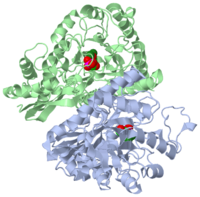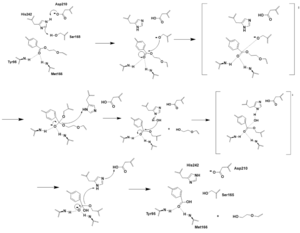Cory Tiedeman Sandbox 1
From Proteopedia
| Line 25: | Line 25: | ||
The | The | ||
<scene name='Cory_Tiedeman_Sandbox_1/Active_sice/1'>active site</scene> of enolase as shown, involves Lys 345, Lys 396, Glu 168, Glu 211, and His 159. Enolase forms a complex with | <scene name='Cory_Tiedeman_Sandbox_1/Active_sice/1'>active site</scene> of enolase as shown, involves Lys 345, Lys 396, Glu 168, Glu 211, and His 159. Enolase forms a complex with | ||
| - | <scene name='Cory_Tiedeman_Sandbox_1/Mg/ | + | <scene name='Cory_Tiedeman_Sandbox_1/Mg/3'>Mg 2+</scene> at its active site. The Mg 2+ then forms a bond with 2PG to connect it with enolase. Fluoride ions inhibits glcolysis by forming a bond with Mg 2+ thus blocks the substrate (2PG) from binding to the active site of enolase.<ref>{{text book |author=Voet, Donald; Voet, Judith C.; Pratt, Charlotte W.|title=Fundamentals of Biochemistry: Life at the Molecular Level|edition= 3|pages=500|}}</ref> |
==References== | ==References== | ||
{{Reflist}} | {{Reflist}} | ||
Revision as of 18:52, 1 March 2010
| |||||||||
| 1one, resolution 1.80Å () | |||||||||
|---|---|---|---|---|---|---|---|---|---|
| Ligands: | , | ||||||||
| Non-Standard Residues: | |||||||||
| Activity: | Phosphopyruvate hydratase, with EC number 4.2.1.11 | ||||||||
| |||||||||
| |||||||||
| Resources: | FirstGlance, OCA, PDBsum, RCSB | ||||||||
| Coordinates: | save as pdb, mmCIF, xml | ||||||||
Enolase is an enzyme that catalyzes a reaction of glycolysis. Glycolysis converts glucose into two 3-carbon molecules called pyrubate. The energy released during glycolysis is used to make ATP.[1] Enolase is used to convert2-phosphoglycerate (2PG) to phosphoenolpyruvate (PEP) in the 9th reaction of glycolysis.[2]
Structure
The of enolase contains both alpha helices and beta sheets. The beta sheets are mainly parellel[3]. As shown in the figure, enolase has about 36 alpha helixes and 22 beta sheets (18 alpha helices and 11 beta sheets per domain).
Structural Clasification of Proteins (SCOP)[4]
Class: alpha and beta proteins (a/b)
Fold: TIM beta/alpha-barrel
Superfamily: Enolase C-terminal domain-like
Family: Enolase
Species: Baker's yeast (Saccharomyces cerevisiae)
Mechanism
The of enolase as shown, involves Lys 345, Lys 396, Glu 168, Glu 211, and His 159. Enolase forms a complex with at its active site. The Mg 2+ then forms a bond with 2PG to connect it with enolase. Fluoride ions inhibits glcolysis by forming a bond with Mg 2+ thus blocks the substrate (2PG) from binding to the active site of enolase.[5]
References
- ↑ text book
- ↑ text book
- ↑ The scop authors. Structural Classification of Proteins. “Protein: Enolase from Baker's yeast (Saccharomyces cerevisiae). 2009. 2/26 2010. [<http://scop.mrc-lmb.cam.ac.uk/scop/data/scop.b.d.b.bc.b.b.html>.]
- ↑ The scop authors. Structural Classification of Proteins. “Protein: Enolase from Baker's yeast (Saccharomyces cerevisiae). 2009. 2/26 2010. [<http://scop.mrc-lmb.cam.ac.uk/scop/data/scop.b.d.b.bc.b.b.html>.]
- ↑ text book



